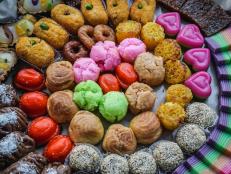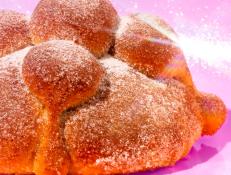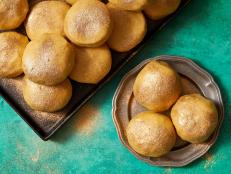What is Nikkei? The History of Japanese Influence on Peruvian Food
Over 100 years ago, a confluence of Peruvian ingredients and Japanese culinary techniques revolutionized Peru's cuisine.

Smith Collection / Gado / Getty
Ceviche probably sounds familiar to you: diced cubes of raw fish marinated in lime juice with some thin slices of red onion, chopped cilantro, a touch of aji (hot pepper) and salt to taste. To water down the spice, maybe some sweet potato and choclo (corn) are added on the side.
But the origin of the dish isn't as well-known as its name.
Traditionally, people in Lima, Peru would “cook” the fish in lime for hours — and even overnight. But over 100 years ago, Japanese immigrants taught Peruvians to simply drizzle some lime juice on top of the raw fish right before serving, says chef Mitsuharu “Micha” Tsumura, owner of one of the World’s 50 Best restaurants: Maido in Peru. As rich in culture as in flavor, ceviche is the epitome of Nikkei cuisine.
Simply put, Nikkei food consists of Peruvian ingredients shaped by Japanese techniques. Take tiradito, for example. In Japan, sashimi is served with wasabi and shoyu (soy sauce). But, when a fresh-caught Peruvian fish is spiced with aji and lime, it creates a new level of flavor. “More seasoned than sashimi, lighter than ceviche. A fundamental dish of our Nikkei cuisine,” write Tsumura and Josefina Barron in “Nikkei es Peru.” To Tsumura, the mix of aji, soy sauce and a bit of acidity (from vinegar or lime juice), is a match made in heaven. “It’s like salted chocolate. Or blue cheese and chicken wings. They just suit each other,” says Tsumura.

daniel san martin / Getty
Tiradito
Nikkei cuisine was “baptized” as such due to a journalist’s mistake, who described a dish as Nikkei, says Tsumura. But the original meaning of Nikkei isn’t food-related.
Nikkei or “nikkeijin” alludes to Japanese emigrants and their descendants (Nikkei also refers to Japan’s stock market index, but we’ll focus on the former definition). After the industrial revolution, many farmers in Japan lost their jobs, so the Peruvian government made a deal with the Japanese government to bring some Japanese people to work in coastal plantations — though this deal had its complications; both the work and assimilation wasn’t exactly easy on the Japanese. When 790 Japanese immigrants arrived in Peru in 1899 per the Asociacion Peruano Japonesa (Peruvian Japanese Association), adapting was difficult. “We don’t have a ‘Little Tokyo’ in Peru, so the only way for them to survive was to blend in with society,” Tsumura says.
After their plantation contracts ended, the now-Peruvian residents had to get creative. While some opened grocery stores, others founded barber shops and restaurants. But the restaurants didn’t serve Japanese dishes — let alone sushi. “It was impossible,” Tsumura says. “Eating octopus or squid hadn’t even crossed the minds of Peruvians.” The typical seafood dishes at the time consisted of two kinds of fish: corvina (sea bass) — which was luxurious — and bonito, which was more affordable. “Peruvians didn’t realize that there are many fish in the sea,” Tsumura says. “So it was a learning process, and the Japanese began introducing the possibility of using a greater variety of seafood.”
With time, small cevicherias started opening in Lima — many of which still exist today, such as La Buena Muerte and Costanera 700. This was the start of a new cuisine, which eventually became what we now know as Nikkei. “We wouldn’t have the cevicherias we currently have in Lima if it weren’t because of the Japanese immigrants who started these restaurants,” Tsumura says.
According to the chef, the creation of Nikkei dishes came in two waves. At first, Peruvian food took cues from Japanese techniques — like ceviche, tiradito or pulpo al olivo (octopus with olive mayonnaise, which is usually consumed as an entreé). Then, Japanese food intertwined with Peruvian techniques and flavors, resulting in dishes such as the acevichado roll, which consists of avocado and tempura shrimp on the inside covered by a sliver of tuna and acevichado sauce. A blend of mayonnaise and leche de tigre (the lime-based marinade used to cure seafood when making ceviche), this sauce has crowned the acevichado roll as the “most Peruvian of all makis.”

Juan Jose Napuri / Getty
Acevichado Roll
The emblematic roll was created at Matsuei, the same restaurant where two of the most important ambassadors of Nikkei cuisine, Toshiro Konishi and Nobu Matsuhisa (yes, the chef responsible for Nobu – one of the world’s most prestigious fine dining chain restaurants) once worked. “Nobu was a pioneer promoting Peruvian cuisine,” Tsumura says. “When he started selling Nikkei dishes around the world, no one else was doing that.”
To Tsumura, although Japanese cuisine is delicious — and so is Peruvian — Nikkei food is the summum of both. Many people around the world can’t eat a traditional ceviche because they’ll find it too acidic, he says. “To me, if you eat a ceviche without making a face then it doesn’t have enough power – it has to kick in. And when it comes to Japanese cuisine, the opposite happens: Some think that there is something missing. That it needs more strength.”

Pocho Caceres / Courtesy of Maido
The chef sticks to the belief that opposites attract. “Peru is like strong salsa music and Japan is like classical music. When you mix these two things together, you create balance.” By lowering the strength of Peru a little bit, and raising the subtlety of Japan a few levels, you end with a product that is more flavorful — and appealing — for people all over the world, he says.
Nowadays, whether you’re in London, Miami or Spain, you’ll find many restaurants serving ceviche also feature sushi in their menus. “The world of the raw is united,” Tsumura says. “You have fish and seafood at the same bar, but some dishes are prepared with leche de tigre while others are combined with rice.” And restaurants don’t need to be labeled as Nikkei for them to serve Nikkei dishes. Most Peruvian restaurants around the world have at least one Nikkei plate in their menu, he adds.

Pocho Caceres / Courtesy of Maido
Chef Tsumura
When Tsumura opened Maido in 2009, his main goal was to make people happy. Years later, as the restaurant — and Peruvian food in general — started gaining worldwide popularity, the chef saw it as an exciting opportunity. “We’re at a beautiful, post-pandemic moment in which the international demand for Peruvian food is exceeding the supply,” Tsumura says. “This isn’t ideal, but it also tells us how valued Peruvian chefs are at a global level.”
In the same way you can buy olive oil and shoyu at Whole Foods or Walmart, the chef hopes that one day people won’t have to fly all the way to Peru (or find a specialized market elsewhere) to purchase some aji amarillo or papas nativas (native potatoes). “My dream is that everyone can make some Peruvian dishes at home. Anywhere in the world. That’s when we’ll know we’ve made it. That’s when we’ll realize how important — and transcendental — Nikkei cuisine is.”
Related Links:


































